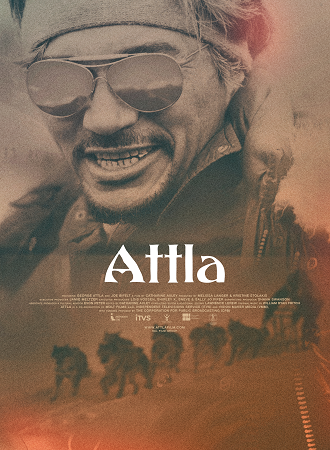
ATTLA 2019
Distributed by Good Docs
Produced by Melissa Langer and Kristine Stolakis
Directed by Catharine Axley
Streaming, 60 mins
General Adult
Native Americans; Sports
Date Entered: 12/11/2019
Reviewed by Andy Horbal, Cornell University LibraryWhen director Catharine Axley began production on the documentary that ultimately became known as ATTLA in 2014, her subject embodied the ideal of a “living legend.” At more than 80 years old, George Attla had long since retired from sled dog racing, but as the only ten-time winner of the Fur Rendezvous Open World Championship, an eight-time winner of the Open North American Championship, and the inspiration for a critically-acclaimed 1979 film Spirit of the Wind, he still loomed large over the sport. He also represented one of its last remaining links to a bygone era when Alaska Native fur trappers would pool the best dogs from their rural villages into teams that were nearly unbeatable at the big races.
The film’s opening scenes feature Attla looking on from a snowmobile as his grandnephew Joe Bifelt hitches a team of dogs to a sled. Although not an aspiring professional musher (as sled dog racers are known) himself, Bifelt had returned to his and Attla’s hometown of Huslia, Alaska to take advantage of a “once in a lifetime opportunity” (as he describes it in a meeting with University of Alaska Fairbanks administrators to make arrangements to study remotely for a year) to spend time with a village elder and learn more about a disappearing part of his culture. The goal: to prepare Bifelt, who titles note had only been on a dogsled twice, to run in the Open North American four months hence by having him go on training runs with a GoPro camera and reviewing the footage together afterward.
The body of the film mixes archival footage and talking heads interviews in with its contemporary narrative about Bifelt to tell the story of Attla’s life and career. After being diagnosed with tuberculosis at a young age, Attla was sent hundreds of miles away from his family to a hospital in Sitka, Alaska for treatment. When he returned home years later, he had forgotten his native language and walked with a permanent limp, marking him as an outsider. By first taking care of the dogs the family used for trapping, and then racing teams of his own dogs and others from the village, he was able to find a place in the community. In 1958 he entered and won the “Fur Rondy” Open World Championship in Anchorage as a complete unknown and the rest, as they say, is history.
ATTLA’s biggest weakness is probably its relatively superficial treatment of its subject’s mushing career. At one point, for instance, archival audio footage from a radio broadcast mentions “Dr. Lombard,” but the film makes no mention of the fact that he was an eight-time Fur Rondy champion and Attla’s greatest rival. Similarly, although the film includes an interview with Gareth Wright where he describes competing in the ‘58 race where Attla made his mark, it is not clear that he was the reigning champion and favorite. More explanation about the differences between the “sprint” mushing events that Attla was best known for and the more famous long-distance Iditarod race that he also competed in twice might also have been welcome to people new to the sport. Viewers curious to know more can easily fill in these gaps with the aforementioned film Spirit of the Wind, which was re-released on DVD in 2014, and Lew Freedman’s biography of Attla by the same name, though, and in the meantime ATTLA does succeed in capturing the hard work and dedication required to be a successful musher. Additional strengths include effective original music by William Ryan Fritch and B-roll footage which skillfully captures the harsh beauty of the Alaskan landscape.
Although this is definitely a film about George Attla, the final ten minutes belong to Joe Bifelt. Following a moving visit to see his granduncle (who died of cancer during filming) in the hospital, we watch him compete in the Open North American, where he finishes a very respectable 19th place out of 24 finishers, and then return to school to complete his degree in elementary education. End titles note that “he plans to return to Huslia to teach and introduce kids to dog mushing,” and the credits roll over footage from his college graduation. It’s the perfect note to end on for a film that is clearly just as interested in the impact that Attla will continue to have on his community in the future through the people he influenced as it is in his storied past.
Awards
Best Documentary Feature, American Indian Film Festival; Best Indigenous Feature, BendFilm Festival